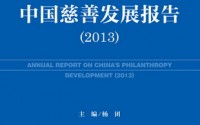FTI, A True Chinese Innovation
The term “social innovation” is catching fire in China, but Mr.Cheng Gang, the president of China Foundation Center ( CFC ), has always been cautious about what you call “social innovation”. He commented at a conference at Tsinghua University not long ago, “If you are doing something for the first time, while people outside the country have done the same thing for a long time, you can’t call it an innovation simply because you don’t know about it. ” Following this logic, he modestly doesn’t consider the China Foundation Center ( CFC ) to be a real innovation, although it’s widely viewed the other way around in the field and by the media.
In August 2012, CFC launched the Foundation Transparency Index ( FTI ), which is a comprehensive set of 60 indicators to determine how transparent a Chinese foundation is. Each indicator is assigned a carefully crafted score and weight, and then foundations are ranked on the total score. At the end of 2012, CFC held a press release, disclosing the most and least transparent foundations according to the scores.
Scoring an organization doesn’t sound like a whole new idea, in the nonprofit sector; Charity Navigator has been doing this for some time. However, putting FTI in a Chinese context, I believe FTI is a real innovation. Before we go into details, let me point out that CFC is a voluntary nonprofit organization. It has no government background, and it is not a membership organization either.
Firstly, FTI offers a creative way to allow CFC to get a stable supply of data. Although CFC is modeled after Foundation Center (FC) in the States and aspires to build itself as an “information platform” for Chinese philanthropy, it is totally different from Foundation Center in many ways. One of the major differences lies in the source of data, essential “raw materials” for both organizations. Foundation Center has a stable supply of data, that is, Form 990 from IRS, but CFC didn’t have access to the data it would need. In China, nonprofit organizations, including foundations, are supposed to submit their audited annual report, an equivalent of Form 990, to its registered administration, often Ministry of Civil Affairs (MCA) or MCA’s provincial or municipal branches, by March 31 every year, then some government-designated agency/media should publish the report within 30 days after the report is approved. Something went wrong in this process. The fact is data on 2010 report were still not available by the end of 2012.
FTI searches the public domains for foundation data. Suppose you are a foundation in China. If they can’t find your annual report in public media, even though you may have already submitted your report to your MCA administration, they will consider it as “no data”, and then you should be prepared to see a low score. You don’t want to be low in the ranking, then what would you do? You would probably decide to publish your report somewhere on the internet. FTI encourages foundations to publish their data timely on the foundation’s own official web site, which is assigned a weight of 1.2, compared with the weight of 0.8 for “other channels”. For those foundations who don’t have an official web site, they can upload their report to a CFC-operated site, which is also considered as an “official web site” and applies to the weight of 1.2.
According to CFC, any foundation that has published their annual report can score at least 50. As of March 31, 1313 out of the total of 3089 foundations score above 50. When CFC was founded in mid 2010, they didn’t even have a full list of all foundations in China. Now with FTI, they are able to have obtained detailed data from 43% of the foundations. And the percentage is predictably going up. The data allow CFC to be a huge step closer to its position as an “information platform”.
Secondly, FTI offers a tangible way to engage the public. Both Mr. Xu YongGuang, the Chair of Board at CFC, and Mr. Cheng Gang believe the key to transparency should not be held in the hand of the government, but the public. In recent years, the public enthusiasm toward the nonprofit sector has soared. At the same time, the public have put the sector under higher scrutiny. Unfortunately, people don’t have enough information or knowledge to help them make a sound judgment. As a result, they sometimes tend to throw the baby out with the bathwater. The Guo MeiMei incident in 2011, which put China Red Cross Society ( CRCS) at the epicenter of a scandal, was a good example. Although it finally turned out that Guo MeiMei had nothing to do with CRCS, the damage was done, not just to CRCS, but also to the whole sector. Many people are still cynical about institutional charity today. People in the nonprofit sector have described the decreasing public credibility as “If one person in the sector gets cold, the whole sector is forced to take medicine with him.”
FTI is no silver bullet to cure public credibility, but it does offer the public with objective data to look at, and a tangible way to help them with their donation decisions. You may argue the most transparent organizations may not be the most effective or competent organizations. This is a fair argument, but it is probably also safe to say that the least transparent organization is unlikely to be the most effective. Meanwhile, when all data are presented at a central place, it will facilitate comparisons vertically with historical data and horizontally among different organizations. These comparisons will be able to assist people to reach more informed decisions. Currently all the data are open to the public for free.
Thirdly, CFC has taken an innovative and effective approach to promote FTI among foundations. As mentioned earlier, CFC has no authority power over any foundations. To avoid objections from foundations, CFC decided not to position FTI as an evaluation mechanism. Over 40 of the 60 indicators are compliance requirement from laws, which foundations should meet anyway. The scoring system was constructed to allow full scores, as long as the foundation is willing to make some extra efforts. So FTI is not judging whether a foundation is transparent or not, but demonstrating how transparent it is in the spectrum of the 60 indicators.
At the same time, CFC engaged participation from leaders in nonprofits, philanthropy and academia in the design and trial of FTI from early on to create buy-in. Meanwhile, when FTI was launched in August 2012, CFC intentionally used data from 2010, but publicly announced the scoring would be based on 2011 data at the end of 2012, so that the foundations would have 3 months to adjust and update their disclosure. CFC spared no efforts to familiarize foundations with FTI. CFC publicized scoring rubrics, and shared tips with foundations on how to boost their scores. Mr.Cheng has stated in every public occasion that FTI is not intended to judge foundations, but to promote the overall transparency among foundations. He thinks all foundations should aim to achieve full scores, and all foundation are able to achieve full scores.
On December 26, 2012, CFC held a press conference to release its first Transparency Report. The conference was well attended by representatives from foundations, academia and media, including mainstream media like People’s Daily. The FTI average was 46.68 at the beginning of 2013, and now it has gone up to 50.17 as of March 31. Certainly foundations would understandably remain indifferent to FTI, but the 20% increase in average score is a good indication that FTI has been well received.
Besides the desired outcome, FTI seems to have played a role it didn’t intend – it has facilitated peer learning among foundations. FTI encourages foundation to publicize its management principles and operation rules, expecting to put the foundations’ execution under public scrutiny. It turned out that the less experienced foundations have taken advantage of the disclosure and have learned from the more experienced foundations.
FTI is so far a clear win. CFC has established a stable supply of data; the public now have access to objective data to help them make more informed decisions; foundations are both challenged and encouraged to perform better disclosure, and they will probably soon learn the disclosure should require higher performance. Considering the circumstances and constraints it was faced with, the breakthrough it has achieved, and the approaches CFC has taken to achieve these positive outcomes, I would, without hesitation, consider FTI as a true innovation.
However, some questions do remain in my mind. Redundancy seems to exist among some indicators. Now that CFC has the data, does it have the data-mining capacity to make the most of the data for further value? How should CFC really engage and educate the public to understand and to incorporate FTI and other data into their judgment and decisions? Or is this beyond CFC’s responsibility? As transparency itself doesn’t automatically translate into effectiveness and impact, will engaging the public to use FTI in their charity decisions also run the risk of making ill-conceived decisions?
That said, CFC has played a wonderfully smart game, and I can’t help expecting more excitement from them in the years ahead.
Additional resources:
- Want to check out on a Chinese foundation? They do have an English version; But please be aware that the English version doesn’t have the most current info.
- Learn more about the methodology of FTI
- China Foundation Transparency Index 2012: Top 50, by Ricky, April 28, 2013, via ChinaAbout.net
- Are Chinese foundations more transparent than American foundations? by Bradford Smith, September 19, 2012, via PhilanTopic
- At the Forefront of Foundation Transparency – An Interview with Zhuang Ailing, CEO of the China Foundation Center, by Fu Tao, China Development Brief, no.47 (Fall 2010)




No Responses